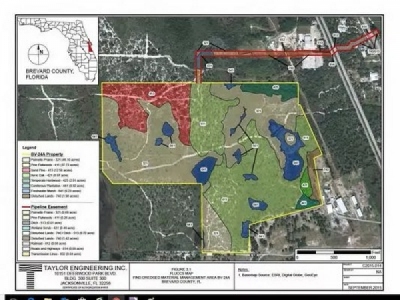
Posted on April 24, 2018
By Jim Waymer, florida today
Dredging of a 15-mile stretch of the Indian River Lagoon from Sebastian to Palm Bay is on the horizon.
If a permit from the U.S. Army Corps of Engineers is issued, the Florida Inland Navigation District could begin construction on a dredge material storage area in about a year.
It would take another year to complete, said Mark Crosley, FIND’s executive director. So, the actual dredging of the 15-mile span of the Intracoastal Waterway from Palm Bay to Sebastian likely would then start in 2020 or 2021, delivering deep-draft access to Palm Bay and Turkey Creek.
During dredging, a mixture of sediment and water would be pumped through a pipe to the 65-acre storage area, where sediment would settle and water would flow by pipeline back to the Indian River Lagoon.
A deep channel draws owners of bigger, more expensive boats from outside the county to check out Brevard County. They dock at local marinas. They stay for weeks on end, buy gas, eat out and shop nearby. The intracoastal fuels $30 billion in economic activity per year, a FIND study shows, justifying the $15 million per year it costs to maintain the channel.
Originally dredged to 12 feet deep, as a military and commercial route, the Intracoastal Waterway has evolved into an expressway for recreational boats. As traffic from commercial vessels dwindled, the Corps let the channel fill in and become the state’s responsibility.
Now, maintaining the intracoastal falls to FIND, which taxes 11 coastal counties to maintain the channel, including the Treasure Coast.
FIND has applied for a federal permit to create an almost 65-acre storage area in Grant-Valkaria to pump sediments dredged from the main channel through the Indian River Lagoon.
The storage area, about a quarter-mile northwest of the intersection of U.S. 1 and Seventh Street, would enable FIND to dredge about 15 miles of the Intracoastal Waterway, from just south of Turkey Creek to Sebastian Inlet, deepening the channel to 12 feet.
The Intracoastal Waterway is the main channel that goes through the Indian River Lagoon. The city of Palm Bay hopes to dredge another channel that would link the lagoon to a proposed pier, marina and mooring field in the mouth of Turkey Creek, which is in the early planning stages.
The city plans two public meetings at to discuss the pier project options: April 25 at City Council Chambers and May 15 at Pelican Harbor Marina. Both meetings start at 6:30 p.m.
Crosely would not speculate on how much the dredging storage area will cost, but said similar dredge material storage areas range from $2 million to $7 million. Nor has it been determined how much dredging 15 miles of the Intracoastal Waterway will cost.
The state and the U.S. Army Corps of Engineers dredged about six miles of the channel in Titusville in the summer of 2002 for about $7 million.
The Palm Bay to Sebastian dredging would discharge “clean fill material” into a half-acre of wetlands to the planned 65-acre Dredge Material Management Area. The site includes 9.23 acres of freshwater marsh and 1.46 acres of wetlands and tributaries, according to the Corps public notice.
The Florida Inland Navigation District has applied for a federal permit to create a 65-acre dredge spoil management area in Grant-Valkaria.
The dredge material storage area was designed to minimize impacts to surrounding properties, scrub jay habitat and impacts from salty lagoon water in groundwater, the public notice says.
“I don’t cut down a tree or harm any animal I don’t need to,” Crosley said.
FIND has proposed to buy mitigation credits in the Mary A Mitigation Bank in South Brevard to offset any habitat destruction caused by the dredge material storage area.
Mitigation banks are managed conservation areas that developers and others pay into to improve and protect habitat to make up for the habitats their projects destroy.
While the main purpose of the ICW dredging is navigation, Crosley said there could be environmental benefit, as well, because of all the fine materials removed from the bottom of the channel.
It’s material that would get resuspended,” Crosley said. “There is some added benefit for water quality.”
Indian River County commissioners could revisit dredging muck from around the Oslo Road boat ramp. They are considering a much smaller project than the controversial one that angered environmentalists in 2014.
The Corps’ early determination is that the project won’t cause substantial adverse impacts on important fish habitats, the public notice says, but that’s subject to review by the National Oceanic and Atmospheric Administration.
Gary Cameron, of Grant-Valkaria, worries about the environmental impacts of the dredge spoil management area.
“I do appreciate the lagoon,” Cameron said. “But I’m very concerned what they’re pumping out of the lagoon, into my side yard, and what’s it going to do to my groundwater?”
Source: TCPalm





